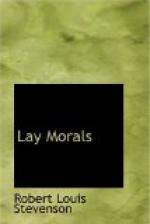When Sharpe first heard of the rebellion, he applied to Sir Alexander Ramsay, the Provost, for soldiers to guard his house. Disliking their occupation, the soldiers gave him an ugly time of it. All the night through they kept up a continuous series of ‘alarms and incursions,’ ‘cries of “Stand!” “Give fire!"’ etc., which forced the prelate to flee to the Castle in the morning, hoping there to find the rest which was denied him at home. {6c} Now, however, when all danger to himself was past, Sharpe came out in his true colours, and scant was the justice likely to be shown to the foes of Scottish Episcopacy when the Primate was by. The prisoners were lodged in Haddo’s Hole, a part of St. Giles’ Cathedral, where, by the kindness of Bishop Wishart, to his credit be it spoken, they were amply supplied with food. {6d}
Some people urged, in the Council, that the promise of quarter which had been given on the field of battle should protect the lives of the miserable men. Sir John Gilmoure, the greatest lawyer, gave no opinion—certainly a suggestive circumstance—but Lord Lee declared that this would not interfere with their legal trial, ‘so to bloody executions they went.’ {6e} To the number of thirty they were condemned and executed; while two of them, Hugh M’Kail, a young minister, and Neilson of Corsack, were tortured with the boots.
The goods of those who perished were confiscated, and their bodies were dismembered and distributed to different parts of the country; ‘the heads of Major M’Culloch and the two Gordons,’ it was resolved, says Kirkton, ’should be pitched on the gate of Kirkcudbright; the two Hamiltons and Strong’s head should be affixed at Hamilton, and Captain Arnot’s sett on the Watter Gate at Edinburgh. The armes of all the ten, because they hade with uplifted hands renewed the Covenant at Lanark, were sent to the people of that town to expiate that crime, by placing these arms on the top of the prison.’ {6f} Among these was John Neilson, the Laird of Corsack, who saved Turner’s life at Dumfries; in return for which service Sir James attempted, though without success, to get the poor man reprieved. One of the condemned died of his wounds between the day of condemnation and the day of execution. ’ None of them,’ says Kirkton, ’would save their life by taking the declaration and renouncing the Covenant, though it was offered to them. . . . But never men died in Scotland so much lamented by the people, not only spectators, but those in the country. When Knockbreck and his brother were turned over, they clasped each other in their armes, and so endured the pangs of death. When Humphrey Colquhoun died, he spoke not like an ordinary citizen, but like a heavenly minister, relating his comfortable Christian experiences, and called for his Bible, and laid it on his wounded arm, and read John iii. 8, and spoke upon it to the admiration of all. But most of all, when Mr. M’Kail died, there was such a lamentation as was never known in Scotland before; not one dry cheek upon all the street, or in all the numberless windows in the mercate place.’ {6g}




